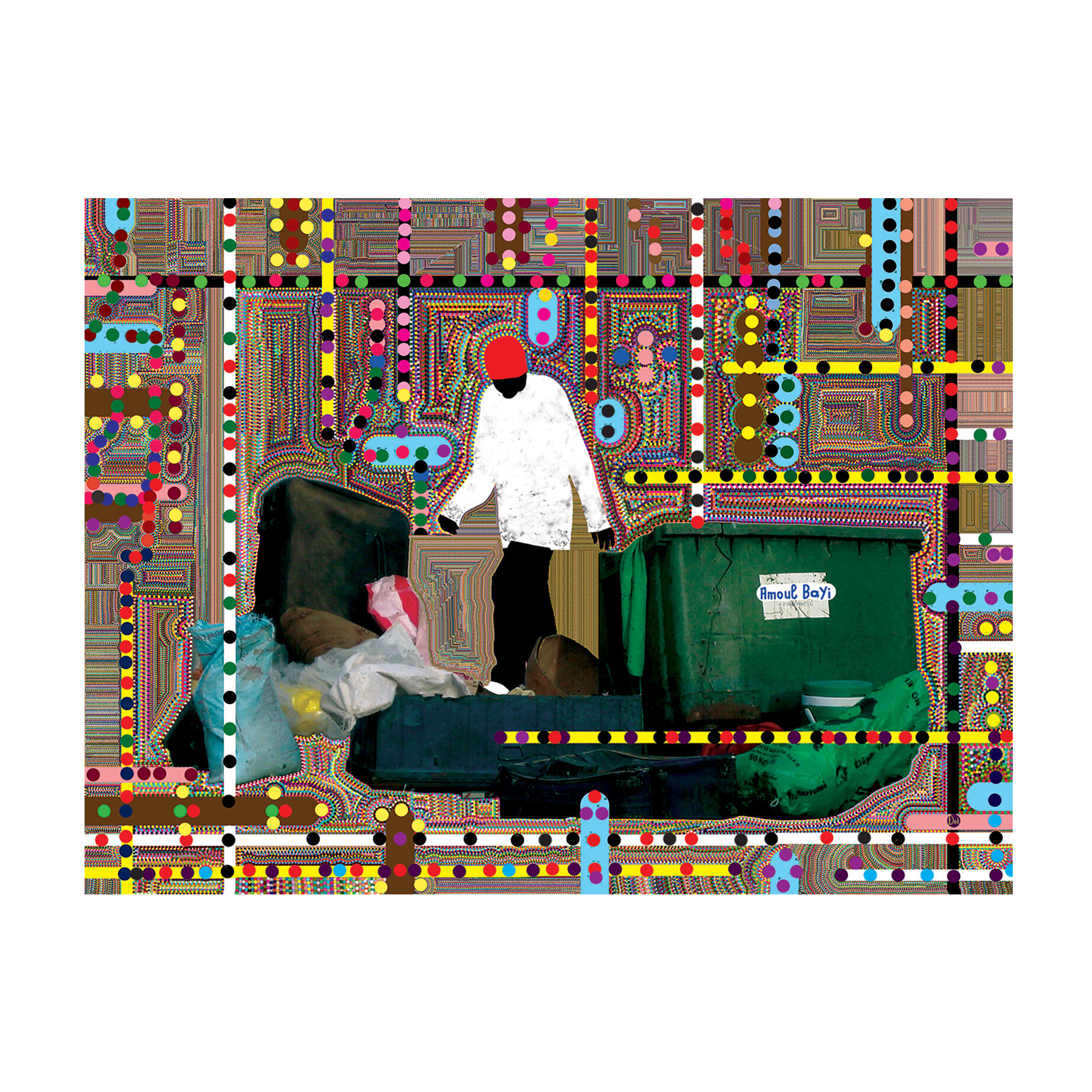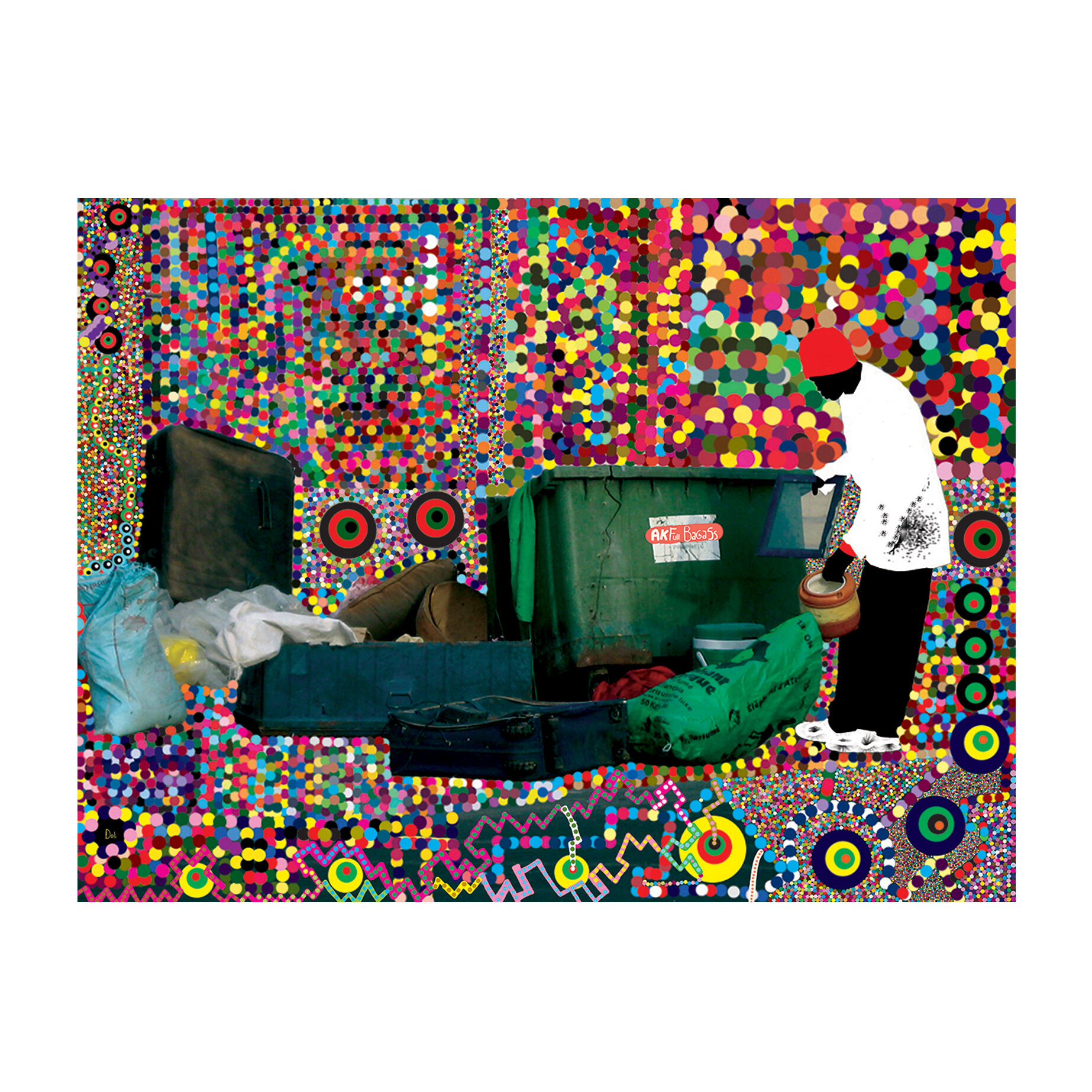Issue # 29 Babacar Traoré Doli
Curated by: Jennifer Houdrouge





From the series - Trésor Retrouvé Liberté d'expression approfondie
Photography and digital paint, 2019 - 2020
For Babacar Traoré Doli, photography starts long before seizing the instaneity of a scene with his camera. He roams for hours through the streets of his native Dakar, from one neighbourhood to the next, from morning to evening, to observe the politics and poetics of urban life.
It is the fleeting assemblage of daily urban scenes that capture his gaze: what the streets conceal in the discreet corners, the small missions of an invisible economy carried out by marginalised people, the inventiveness with which children transform discarded materials into objects of wonder, the city’s architecture overpowered by the urban chaos and the necessities of some.
On the decrepit walls and colonial houses of Medina - a popular area in Dakar established as the native quarter by the French colonial at the beginning of the 20th century - he sees the memories of his own childhood. In « Liberté d’Expression » (freedom of speech), the artist photographed the children’s marks, scribbles and drawings left on those walls. For Doli, « these walls hold the voices of those that can’t speak », they retain the innocence of young passerby. Using digital paint, the artist creates a composition by replicating certain children-inspired motifs or details, granting the works with a painterly quality. The indivisibility and convergence of writings between these invisible hands and Traoré Doli’s marks also the crossing of times: a distant past no longer passed as his own childhood is retained on those familiar walls. Beyond the small details of urban life, it is the larger organization of Dakar’s streets that captivates the artist.
In Trésor Retrouvé (treasure found again), Doli exposes the Bujukaat - a person that survives financially in the Senegalese society by saving from trash, discarded objects to re-introduce them in the circulation of goods. The Bujukaat browses through our once-desired goods, now-reduced to unpleasant debris and with an inventive eye, selects, cleans and sells the piece that can be functional to some: a jar, a stick, a pan. In the artist own words, “there is gold in our waste for the Bujukaat.” Our material crumbs carry the possibility of survival and renewal for those that did not enter the traditional economic wheel of society. For Traoré Doli, the trash that we once thought as vanished, slides back into our consciousness through the Bujukaat’s gesture, to remind us of a disposable society that consumes mindlessly, blindly.
He decomposes the scene in 5 sequences similarly to mythological narrative structure: dusk, early morning, zenith, afternoon and dawn. These 5 acts grants each photograph with a specific moment in the story: from the Bujukaat’s search in the trash to the treasure’s extraction. In addition, the artist digitally paints countless colored dots of varying size, one by one in months-long painting process, dissolving the background.
In Dusk and Morning, the composition resembles an urban colonial plan like that of western cities. Piet Mondrian’s painting « Broadway Boogie Woogie » (1942) which evokes New York’s strict orthogonal urban plan depicted in primary colors comes to mind as a stark contrast to the visual vibrancy of the Medina-inspired work. In Trésor Retrouvé, the boulevards, main avenues and elegant roundabouts represent the migration of urban forms coming directly from the West. Yet, within Traore’s work, it is visible that pockets of streets, communities and stories obey their own rules, their own internal rhythm - the urban reality of most African capitals formerly colonized.
In Zenith, Afternoon and Dawn, the circular marks gradually overflow the carefully-designed geometric composition, as if Dakar’s street madness that emerges in the daylight and soothes at dawn, imposes itself and prevails over the rational city plan. A throbbing rhythm stems from each piece: we hear with our eyes the cacophonous sounds of traffic, the street sellers, the distant musical rhythms, and imagine all the elements that makes Dakar a poetically delightful and tiring city. Poetic for those that pay attention to details like Traoré Doli; resourceful for the inventive ones in need like the Bujukaat.
As trash becomes treasure, this marginalized individual performing a supposedly trivial act, becomes an urban alchemist carrier of a fresh gaze, a fighter against the generalised throw away current. In an eternal consumption and production of waste, this daily ritual endlessly repeats one day after the next for the Bujukaat. Under the pondering sun, he drifts from trash to trash, with the hope to find in the undesirable residue of collective living, what will allow him to subsist in the cycle of society.





From the series - Liberté d’expression, Chalk on wall.
Babacar Traoré Doli (b.1984, Médina - Dakar, Senegal) is a multidisciplinary artist based in Dakar, Sénégal. Originally trained as a graphic designer, he developed his artistic practice amongst his peers at Espace Médina where he grew up – a cultural and historical site in Dakar from the 1960s. His solo exhibitions include “L’homme et son environnement” at Manuka Art Center in Canberra, Australia (2021); “Carte Blanche” at Gorée Institute in Dakar (2018), “Liberté d’expression” at Fondation Friderich Ebert in Dakar (2016), “Ecriture en couleur” at Galerie Ataya in Saint Louis Sénégal (2014); “Jaxasé – L’homme et son environnement” as Dak’Art Biennial OFF at Goethe Institute (2013). In addition, he has participated in a number of group exhibitions: « Regards sur Cours » at l’Ile de Gorée in Dakar (2018); “Vague à l’a(r)me” at Loman Art House (2018); « La cloche des fourmis » organized by the Laboratoire Agit’ Art in the Dak’Art OFF Bienniale (2018) ; “La photographie en temps de trouble” at la Quinzaine de la photographie in Cotonou, Bénin (2017) ; Les trésors de la Médina at Galerie Médina in Bamako, Mali (2014); Festival International de la Photographie du Cap Vert (2014); “Le piéton de Dakar” at Galerie le Manège in Dakar (2013), amongst others. He was awarded the Creative Prize (Prix de la Créativité) at the Quizaine de la Photographie Festival in Cotonou, Bénin in 2018 and included in the “Salon Geew Bi” organized by the Dakar French Institute (2020).
Jennifer Houdrouge is a curator and writer. She holds an Masters in Art History and Archeology from the Institute of Fine Arts, New York University, a Masters in Contemporary Art at Sotheby’s Institute of Art in New York and a Bachelor from King’s College, London. While working at Gladstone Gallery in New York and later the Solomon R.Guggenheim museum, she co-founded the exhibition venue The Chimney, a former powerstation in Brooklyn, New York, hosting more than 30 site-specific exhibitions. In 2020, she opened Selebe Yoon - a residency and gallery in Dakar, Senegal. Jennifer is based between Europe and Dakar.
.

